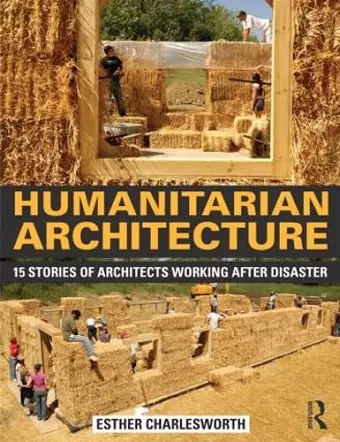Humanitarian Architecture
15 stories of architects working after disaster
Format:Hardback
Publisher:Taylor & Francis Ltd
Published:25th Jun '14
Currently unavailable, and unfortunately no date known when it will be back
This hardback is available in another edition too:
- Paperback£39.99(9780415818674)

Never has the demand been so urgent for architects to respond to the design and planning challenges of rebuilding post-disaster sites and cities. In 2011, more people were displaced by natural disasters (42 million) than by wars and armed conflicts. And yet the number of architects equipped to deal with rebuilding the aftermath of these floods, fires, earthquake, typhoons and tsunamis is chronically short.
This book documents and analyses the expanding role for architects in designing projects for communities after the event of a natural disaster. The fifteen case studies featured in the body of the book illustrate how architects can use spatial sensibility and integrated problem-solving skills to help alleviate both human and natural disasters. The cases include:
- Lizzie Babister - Department of International Development, UK.
- Shigeru Ban - Winner of The Pritzker Architecture Prize 2014, Shigeru Ban Architects and Voluntary Architects’ Network, Japan.
- Eric Cesal – Disaster Reconstruction and Resiliency Studio and Architecture for Humanity, Japan.
- Hsieh Ying Chun – Atelier 3, Taiwan.
- Nathaniel Corum - Education Outreach and Architecture for Humanity, USA.
- Sandra D’Urzo - Shelter and Settlements and International Federation of the Red Cross and Red Crescent Societies, Switzerland.
- Brett Moore - World Vision International, Australia.
- Michael Murphy - MASS Design Group, USA.
- David Perkes - Gulf Coast Community Design Studio, USA.
- Paul Pholeros - Healthabitat, Australia.
- Patama Roonrakwit - Community Architects for Shelter and Environment, Thailand.
- Graham Saunders - International Federation of Red Cross and Red Crescent Societies, Switzerland.
- Kirtee Shah - Ahmedabad Study Action Group, India.
- Maggie Stephenson - UN-HABITAT, Haiti.
- Anna Wachtmeister - Catholic Organisation for Relief and Redevelopment Aid, the Netherlands.
The interviews and supporting essays show built environment professionals collaborating with post-disaster communities as facilitators, collaborators and negotiators of land, space and shelter, rather than as ‘save the world’ modernists, as often portrayed in the design media. The goal is social and physical reconstruction, as a collaborative process involving a damaged community and its local culture, environment and economy; not just shelter ‘projects’ that ‘build’ houses but leave no economic footprint or longer-term community infrastructure. What defines and unites the architects interviewed for Humanitarian Architecture is their collective belief that through a consultative process of spatial problem solving, the design profession can contribute in a significant way to the complex post-disaster challenge of rebuilding a city and its community.
'What is humanitarian architecture? What is the role of architects and designers in the field of humanitarian action? This collection of personal stories and practical experiences provides a much needed insight into the business of post-disaster shelter, from individuals whose diverse work with communities affected by natural and man-made crises has done much to shape the understanding of and approach to shelter after disaster.' - Graham Saunders, Head, Shelter & Settlements, International Federation of Red Cross and Red Crescent Societies
'Challenging the conventional "wisdom" about the role of architecture and architects in reconstruction, Esther Charlesworth assembles seminal views from a wide range of experienced professionals looking up and out from the wreckage of cities destroyed by various calamity, to thoughtful insights of academics on design vs. construct, and reflections on innovations past and future. A must-have reference in the libraries of professionals engaged in supporting the recovery and reconstruction of towns and cities struck by war, disaster, or decay.' - Dan Lewis, Chief, Urban Risk Reduction, UN-Habitat
'A ground-breaking book that is essential reading for students, designers and recovery officials. Containing rich experiences by leaders in the field and highly creative designers, this will inspire, inform and guide readers to become involved in a noble humanitarian cause.' - Ian Davis, author of Shelter after Disaster (1978), visiting Professor in Disaster Risk Management in Copenhagen, Lund, Kyoto and Oxford Brookes Universities
'Why aren’t we better prepared for these frequent disasters that devastate communities? We can and should do better. We have an obligation to humanity to make progress each time. These fifteen cases in Humanitarian Architecture: 15 stories of architects working after disaster are a good way to learn from what experts have done and how we can all move forward from here.' - Bryan Bell, Founder and Executive Director of Design Corps
ISBN: 9780415818667
Dimensions: unknown
Weight: 650g
264 pages